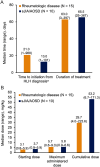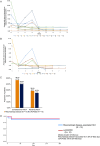Emapalumab Treatment in Patients With Rheumatologic Disease-Associated Hemophagocytic Lymphohistiocytosis in the United States: A Retrospective Medical Chart Review Study
- PMID: 39245963
- PMCID: PMC11782109
- DOI: 10.1002/art.42985
Emapalumab Treatment in Patients With Rheumatologic Disease-Associated Hemophagocytic Lymphohistiocytosis in the United States: A Retrospective Medical Chart Review Study
Abstract
Objective: Rheumatologic disease-associated hemophagocytic lymphohistiocytosis (HLH), a rare, life-threatening, systemic hyperinflammatory syndrome, occurs as a complication of underlying rheumatologic disease. Real-world evidence is lacking on emapalumab, a fully human monoclonal antibody that neutralizes the proinflammatory cytokine interferon-γ, approved for treating patients with primary HLH.
Methods: REAL-HLH, a retrospective medical chart review study conducted across 33 US hospitals, assessed real-world treatment patterns and outcomes in patients with HLH treated with one or more dose of emapalumab between November 20, 2018, and October 31, 2021. Data are presented for the subset of patients with rheumatologic disease-associated HLH.
Results: Fifteen of 105 patients (14.3%) had rheumatologic disease-associated HLH. Of these, nine (60.0%) had systemic juvenile idiopathic arthritis, and one (6.7%) had adult-onset Still disease. Median (range) age at HLH diagnosis was 5 (0.9-39) years. Most patients (9 of 15; 60.0%) initiated emapalumab in an intensive care unit. Emapalumab was most frequently initiated for treating refractory or recurrent (10 of 15; 66.7%) disease. Most patients received HLH-related therapies before (10 of 15; 66.7%) and concurrently with (15 of 15; 100.0%) emapalumab. Emapalumab-containing regimens stabilized or achieved physician-determined normalization of most laboratory parameters, including absolute neutrophil count and absolute lymphocyte count (13 of 14; 92.9%), chemokine ligand 9 (9 of 11; 81.8%), and platelets and alanine transaminase (11 of 14; 78.6%), and reduced glucocorticoid dose by 80%. Overall survival and 12-month survival probability from emapalumab initiation were 86.7%.
Conclusion: Emapalumab-containing regimens stabilized or normalized most key laboratory parameters, reduced glucocorticoid dose, and were associated with low disease-related mortality, thereby demonstrating potential benefits in patients with rheumatologic disease-associated HLH.
© 2024 The Author(s). Arthritis & Rheumatology published by Wiley Periodicals LLC on behalf of American College of Rheumatology.
Figures



References
-
- Schram AM, Berliner N. How I treat hemophagocytic lymphohistiocytosis in the adult patient. Blood 2015;125(19):2908–2914. - PubMed
-
- Cron RQ, Goyal G, Chatham WW. Cytokine storm syndrome. Annu Rev Med 2023;74(1):321–337. - PubMed
-
- Allen CE, McClain KL. Pathophysiology and epidemiology of hemophagocytic lymphohistiocytosis. Hematology (Am Soc Hematol Educ Program) 2015;2015(1):177–182. - PubMed
MeSH terms
Substances
Grants and funding
LinkOut - more resources
Full Text Sources
Medical

